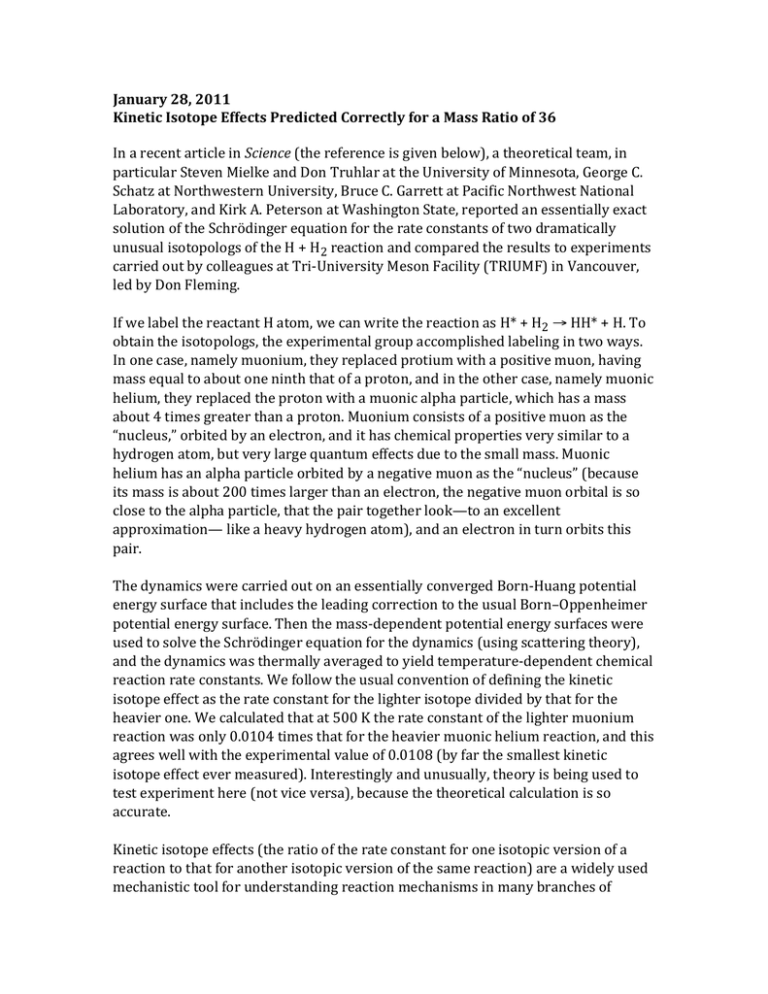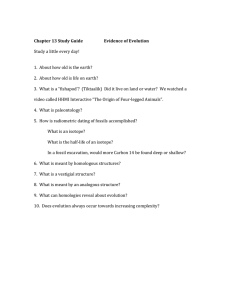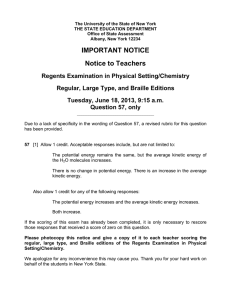Document 14326845
advertisement

January 28, 2011 Kinetic Isotope Effects Predicted Correctly for a Mass Ratio of 36 In a recent article in Science (the reference is given below), a theoretical team, in particular Steven Mielke and Don Truhlar at the University of Minnesota, George C. Schatz at Northwestern University, Bruce C. Garrett at Pacific Northwest National Laboratory, and Kirk A. Peterson at Washington State, reported an essentially exact solution of the Schrödinger equation for the rate constants of two dramatically unusual isotopologs of the H + H2 reaction and compared the results to experiments carried out by colleagues at Tri-­‐University Meson Facility (TRIUMF) in Vancouver, led by Don Fleming. If we label the reactant H atom, we can write the reaction as H* + H2 → HH* + H. To obtain the isotopologs, the experimental group accomplished labeling in two ways. In one case, namely muonium, they replaced protium with a positive muon, having mass equal to about one ninth that of a proton, and in the other case, namely muonic helium, they replaced the proton with a muonic alpha particle, which has a mass about 4 times greater than a proton. Muonium consists of a positive muon as the “nucleus,” orbited by an electron, and it has chemical properties very similar to a hydrogen atom, but very large quantum effects due to the small mass. Muonic helium has an alpha particle orbited by a negative muon as the “nucleus” (because its mass is about 200 times larger than an electron, the negative muon orbital is so close to the alpha particle, that the pair together look—to an excellent approximation— like a heavy hydrogen atom), and an electron in turn orbits this pair. The dynamics were carried out on an essentially converged Born-­‐Huang potential energy surface that includes the leading correction to the usual Born–Oppenheimer potential energy surface. Then the mass-­‐dependent potential energy surfaces were used to solve the Schrödinger equation for the dynamics (using scattering theory), and the dynamics was thermally averaged to yield temperature-­‐dependent chemical reaction rate constants. We follow the usual convention of defining the kinetic isotope effect as the rate constant for the lighter isotope divided by that for the heavier one. We calculated that at 500 K the rate constant of the lighter muonium reaction was only 0.0104 times that for the heavier muonic helium reaction, and this agrees well with the experimental value of 0.0108 (by far the smallest kinetic isotope effect ever measured). Interestingly and unusually, theory is being used to test experiment here (not vice versa), because the theoretical calculation is so accurate. Kinetic isotope effects (the ratio of the rate constant for one isotopic version of a reaction to that for another isotopic version of the same reaction) are a widely used mechanistic tool for understanding reaction mechanisms in many branches of chemistry, for example, in organic chemistry, geochemistry, atmospheric chemistry, and enzyme kinetics. It would be too difficult to solve the Schrödinger equation for complex applications, so those important aplications are usually studied by transition state theory. Here we have a kinetic isotope effect for a mass ratio of 36, which is unprecedentedly large (more typical values being 2 for deuterium vs. protium or 1.08 for isotopes of carbon), so we also took the opportunity to test transition state theory in the form of variational transition state theory, which has been developed over many years at the University of Minnesota, and it performed quite well, especially when one considers the highly quantum nature of muonium. This research was supported in part by the Office of Basic Energy Sciences of the U.S. Department of Energy. Read more: • Original article in Science “Kinetic Isotope Effects for the Reactions of Muonic Helium and Muonium with H2,” Donald G. Fleming, Donald J. Arseneau, Oleksandr Sukhorukov, Jess H. Brewer, Steven L. Mielke, George C. Schatz, Bruce C. Garrett, Kirk A. Peterson, and Donald G. Truhlar, 331(6016), 448-­‐450 (Jan. 28, 2011). http:/dx.doi.org/10.1126/science.1199421 • Perspective in Science “Chemical Kinetics Under Test,” Millard H. Alexander, Science 331(6016), 411-­‐412 (Jan. 28, 2011). http:/dx.doi.org/10.1126/science.1201509 • News Article in Nature “Artificial hydrogen tests quantum theory: Heavy and light analogues of hydrogen probe the limits of quantum chemistry,” Philip Ball, Nature, published online Jan. 27, 2011 http:/dx.doi.org/10.1038/news.2011.48 or http://www.nature.com/news/2011/110127/full/news.2011.48.html • Science & Technology Concentrate in C&E News “Extreme ‘Hydrogen Isotopes’ Illuminate Reaction Kinetics: Using muons to create light and heavy hydrogen mimics, chemists upgrade the kinetic isotope effect,” Elizabeth K. Wilson, Chemical and Engineering News 89(5), 44 (Jan. 31, 2011). http://pubs.acs.org/isubscribe/journals/cen/89/i05/html/8905scic3.html • News Article in New Scientist “Atomic disguise makes helium look like hydrogen,” Kate McAlpine, New Scientist, 209(2798), 8 (Feb. 5, 2011). http:/dx.doi.org/doi:10.1016/S0262-­‐4079(11)60238-­‐8. • News Article in Chemistry World (published by the Royal Society of Chemistry) “Muons take kinetic isotope effects to extremes,” Laura Howes, Chemistry World (Jan. 27, 2011) http://www.rsc.org/chemistryworld/News/2011/January/27011103.asp • Story on TRIUMF home page “How to Achieve Mastery: Understand the Simple Things,” D. G. Fleming (Jan. 27, 2011) http://www.triumf.ca/research-­‐highlights/experimental-­‐result/how-­‐achieve-­‐ mastery-­‐understand-­‐simple-­‐things


